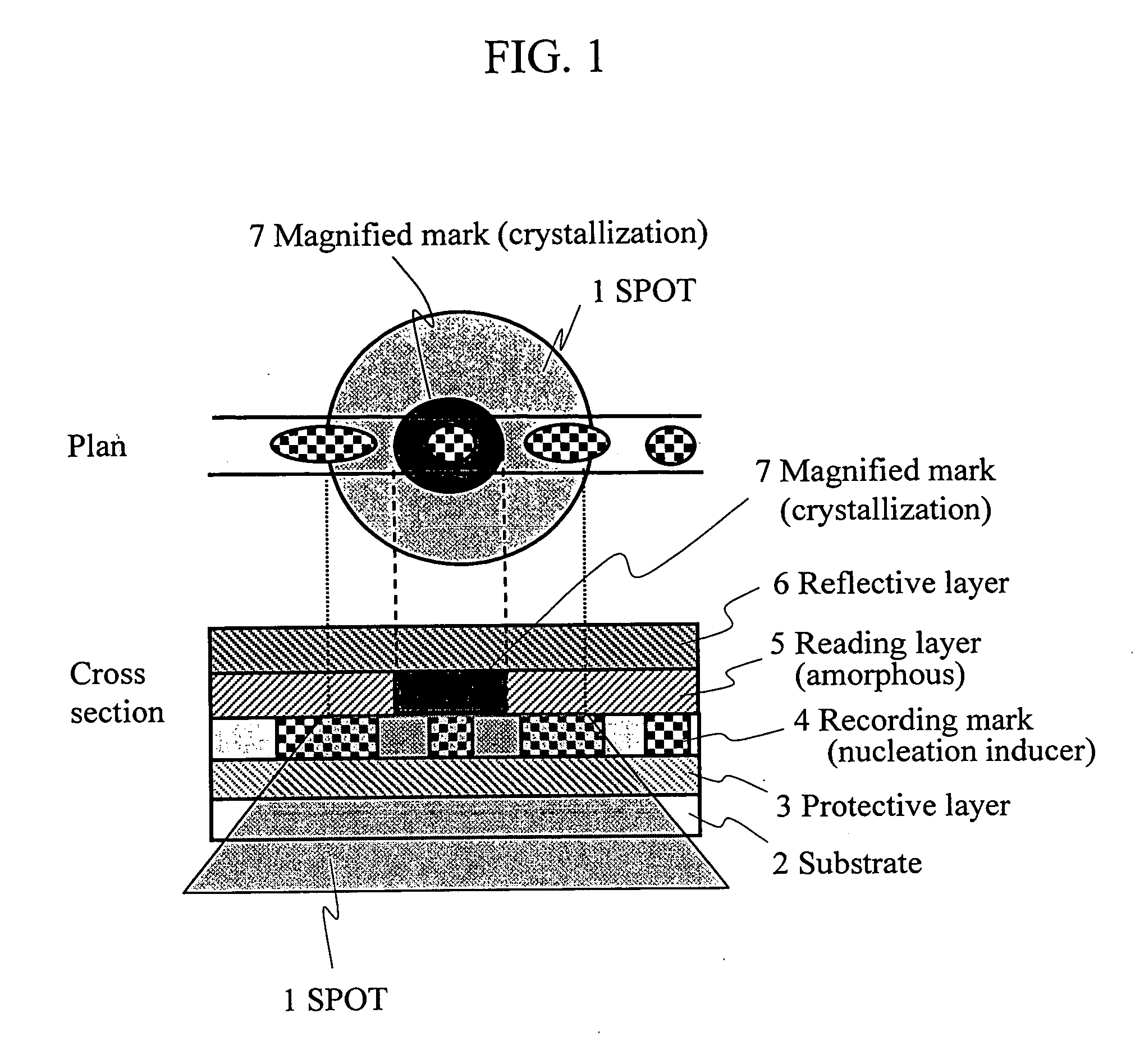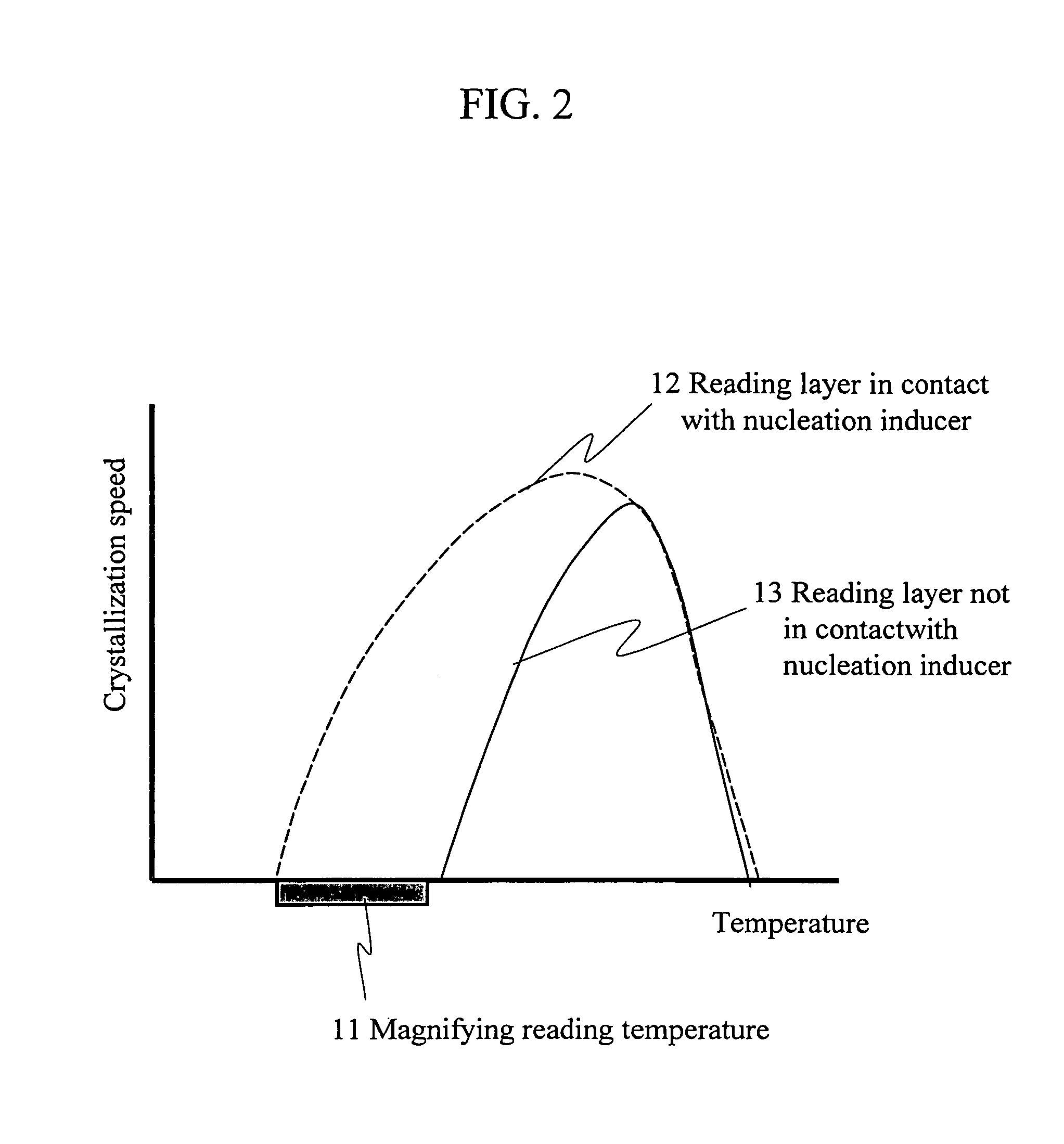Information reproduction method and information recording medium
a technology of information reproduction and information recording, applied in the field of information reproduction method and information recording medium, can solve the problems of difficult construction of apparatus to read both reflective signals and magnetic signals, low snr of reading signals, and decreased reading signals, etc., to achieve less expensive low-power, reduce the cost of low-power lasers, and increase the effect of absorption
- Summary
- Abstract
- Description
- Claims
- Application Information
AI Technical Summary
Benefits of technology
Problems solved by technology
Method used
Image
Examples
first embodiment
[0062] A first embodiment in which magnified marks are formed in a reading layer based on ROM recording marks composed of a nucleation inducer as described above in (1) is explained.
(Composition and Manufacturing Method of Information Recording Medium of the Present Invention)
[0063]FIG. 3 depicts a cross sectional structure of a disk-shaped information recording medium of the first embodiment of the present invention. This medium was manufactured as follows:
[0064] The processes for manufacturing the medium are shown in FIG. 4. First, in Process 1, a reflective layer 6 made of Ag98Pd1Cu1 with a thickness of 200 nm, a protective layer 8 made of Cr2O3 with a thickness of 20 nm, a reading layer 5 made of Ge6Sb2Te9 with a film thickness of 10 nm, a ROM recording mark material 31 made of Bi—Te—N with a film thickness of 20 nm, and a protective layer for ROM mark formation 32 made of SiO2 with a thickness of 20 nm were formed in turn by sputtering over a polycarbonate protective substr...
second embodiment
[0111] A second embodiment in which magnified marks are formed in a reading layer based on WO (write once) recording marks composed of a nucleation inducer as described above in (1) is explained.
(Composition and Manufacturing Method of Information Recording Medium of the Present Invention)
[0112]FIG. 9 depicts a cross sectional structure of a disk-shaped information recording medium of the second embodiment of the present invention. This medium was manufactured as follows:
[0113] The processes for manufacturing the medium are shown in FIG. 10. First, in Process 1, the reflective layer 6 made of Ag98Pd1Cu1 with a thickness of 200 nm, the protective layer 8 made of Cr2O3 with a thickness of 20 nm, the reading layer 5 made of Ge6Sb2Te9 with a film thickness of 10 nm, a WO recording mark material 91 composed of Si—Te—N and Ti—N with a film thickness of 20 nm, and a protective layer 3 made of ZnS—SiO2 with a thickness of 20 nm were formed in turn by sputtering over the polycarbonate pr...
third embodiment
[0125] A third embodiment in which magnified marks are formed in a reading layer based on ROM recording marks composed of a nucleation inducer as described above in (2) is explained.
(Composition and Manufacturing Method of Information Recording Medium of the Present Invention)
[0126]FIG. 13 depicts a cross sectional structure of a disk-shaped information recording medium of the third embodiment of the present invention.
[0127] The reflective layer 6 made of Ag98Pd1Cu1 with a thickness of 200 nm, the protective layer 8 made of Cr2O3 with a thickness of 20 nm, a reading layer 105 made of Ge5Sb70Te25 with a film thickness of 10 nm, a ROM recording mark material 122 composed of Sb—Bi with a film thickness of 20 nm, a protective layer 3 made of SiO2 with a thickness of 20 nm, and the substrate 2 made of an ultraviolet light curing resin with a thickness of ca. 0.1 μm were formed over the polycarbonate protective substrate 7 having a diameter of 12 cm, a thickness of 1.1 mm, and grooves...
PUM
| Property | Measurement | Unit |
|---|---|---|
| thickness | aaaaa | aaaaa |
| thickness | aaaaa | aaaaa |
| diameter | aaaaa | aaaaa |
Abstract
Description
Claims
Application Information
 Login to View More
Login to View More - R&D
- Intellectual Property
- Life Sciences
- Materials
- Tech Scout
- Unparalleled Data Quality
- Higher Quality Content
- 60% Fewer Hallucinations
Browse by: Latest US Patents, China's latest patents, Technical Efficacy Thesaurus, Application Domain, Technology Topic, Popular Technical Reports.
© 2025 PatSnap. All rights reserved.Legal|Privacy policy|Modern Slavery Act Transparency Statement|Sitemap|About US| Contact US: help@patsnap.com



